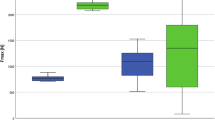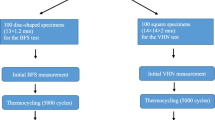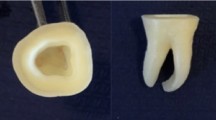Abstract
This study evaluated the impact of different mixing ratios and wrongly stored blends of dual-curing composite cements on Empress2 glass–ceramic crowns by means of a flexural strength test and a fracture resistance test. Thermally damaged blends and fresh blends were mixed using different mixing ratios of dual-curing Panavia F and Variolink II composite cement (2:1; 1:1; 1:1.5; 1:1.75; base/catalyst). Sixteen groups of rectangular beams of both cements (two blends, four ratios, chemical-curing, light-curing) were constructed. Their flexural strength was determined in a three-point bending test. Furthermore, 64 Empress2 all-ceramic crowns were luted onto human molars, again using fresh and thermally damaged blends as well as different mixing ratios of the luting agents. After aging, fracture resistance was investigated. The flexural strength of dual-curing composite cements was influenced to a statistically significant extent by mixing ratios and storage conditions. In particular, the chemical curing mode of these cements was affected by the thermal damage of the blends. However, this study could not demonstrate a significant impact on the fracture resistance of Empress2 glass-ceramic crowns when different mixing ratios or wrongly stored cements were used. Dual-curing composite luting agents seem to tolerate a wide range of mixing errors, but their chemical curing mode may be affected by storage errors.



Similar content being viewed by others
References
Akungor G, Akkayan B, Gaucher H (2005) Influence of ceramic thickness and polymerization mode of a resin luting agent on early bond strength and durability with a lithium disilicate-based ceramic system. J Prosthet Dent 94:234–241
Attia A, Kern M (2004) Influence of cyclic loading and luting agents on the fracture load of two all-ceramic crown systems. J Prosthet Dent 92:551–556
Behr M, Rosentritt M, Loher H, Handel G (2006) Effect of variations from the recommended powder/liquid ratio on some properties of resin-modified cements. Acta Odontol Scand 64:214–220
Brauer GM (1981) Initiator-accelerator systems for acrylic resins and composites. Polymer science and technology, Volume 14, Biomedical and dental applications of Polymers. Plenum, pp 395–409
Darvell BW (2002) Materials science for dentistry. In: Darvell BW (ed) Resin restorative materials, 7th edn. BW Darvell, Hong Kong (ISBN 962-85391-5-9), pp 116–133
Darvell BW (2002) Materials science for dentistry. In: Darvell BW (ed) Mechanical testing, 7th edn. BW Darvell, Hong Kong (ISBN 962-85391-5-9), pp 20–21
deGee AJ, ten Harkel HC, Davidson CL (1989) The influence of mixing ratio on the working time, strength and wear of composites. Aust Dent J 34:466–469
Federlin M, Männer T, Hiller KA, Schmidt S, Schmalz G (2006) Two-year clinical performance of cast gold vs. ceramic partial crowns. Clin Oral Investig 10:126–133
Federlin M, Wagner J, Männer T, Hiller KA, Schmalz G (2007) Three-year clinical performance of cast gold vs. ceramic partial crowns. Clin Oral Investig 11:345–352
Fleming GJ, Marquis PM, Shortall AC (1999) The influence of clinically induced variability on the distribution of compressive fracture strength of a hand-mixed zinc phosphate dental cement. Dent Mater 15:87–97
Hofmann N, Pabsthart G, Hugo B, Klaiber B (2001) Comparison of photoactivation versus chemical or dual-curing of resin-based luting cements regarding flexural strength, modulus and surface hardness. J Oral Rehabil 28:1022–1028
Özcan M, Kerkdijk S, Valandro LF (2008) Comparison of resin cement adhesion to Y-TZP ceramic following manufacturers’ instructions of the cements only. Clin Oral Invest 12:279–282
Pace LL, Hummel SK, Marker VA, Bolouri A (2007) Comparison of the flexural strength of five adhesive resin cements. J Prosthodont 16:18–24
Pospiech P (2002) All-ceramic crowns: bonding or cementing? Clin Oral Invest 6:189–197
Preuss A, Rosentritt M, Frankenberger R, Beuer F, Naumann M (2008) Influence of type of luting cement used with all-ceramic crowns on load capability of post-restored endodontically treated maxillary central incisors. Clin Oral Investig 12:151–156
Proos KA, Swain MV, Ironside J, Steven GP (2003) Influence of cement on a restored crown of a first premolar using finite element analysis. Int J Prosthodont 16:82–90
Rosentritt M, Behr M, Gebhard R, Handel G (2006) Influence of stress simulation parameters on the fracture strength of all-ceramic fixed-partial dentures. Dental Mater 22:176–182
Scherrer SS, de Rijk WG (1993) The fracture resistance of all-ceramic crowns on supporting structures with different elastic moduli. Int J Prosthodont 6:462–467
Stappert CF, Guess PC, Chitmongkolsuk S, Gerds T, Strub JR (2007) All-ceramic partial coverage restorations on natural molars. Masticatory fatigue loading and fracture resistance. Am J Dent 20:21–26
Walker MP, Spencer P, Eick JD (2003) Mechanical property characterisation of resin cement after aqueous aging with and without cyclic loading. Dent Mater 19:645–652
Wilder AD, Boghosioan AA, Bayne SC, Heymann HO, Sturdevant JR, Roberson TM (1998) effect of powder/liquid ratio on the clinical and laboratory performance of resin-modified glass-ionomers. Dent 26:369–377
Conflict of interest statement
The authors declare that they have no conflict of interest.
Author information
Authors and Affiliations
Corresponding author
Rights and permissions
About this article
Cite this article
Loher, H., Behr, M., Hintereder, U. et al. The impact of cement mixing and storage errors on the risk of failure of glass–ceramic crowns. Clin Oral Invest 13, 217–222 (2009). https://doi.org/10.1007/s00784-008-0215-7
Received:
Accepted:
Published:
Issue Date:
DOI: https://doi.org/10.1007/s00784-008-0215-7




